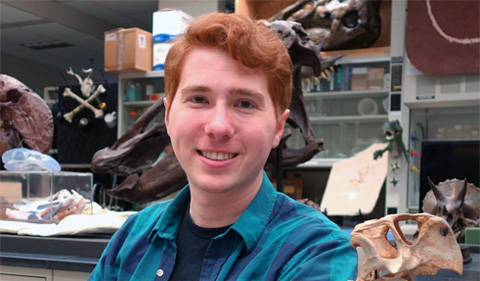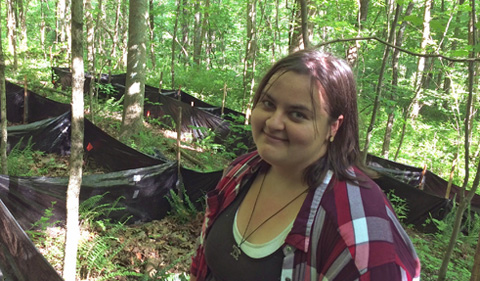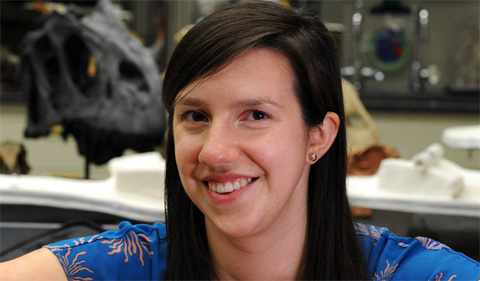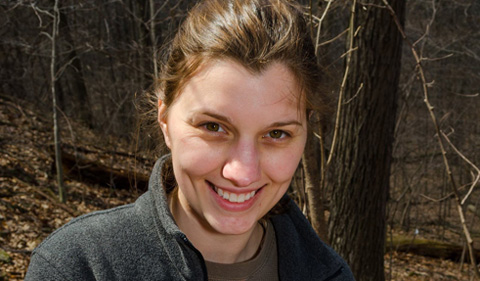Four Ohio University Biological Sciences graduate students were awarded prestigious NSF graduate research fellowships and grants.
James Nassif, a student in Dr. Larry Witmer’s lab, and Cassandra Thompson, in Dr. Viorel Popescu’s lab, were the only Ohio University students awarded NSF Graduate Research Fellowships this year. Both are in the Ecology and Evolutionary Biology Program in the Biological Sciences Department, The fellowships provide a very generous stipend for three years plus tuition expenses.
Catherine Early, another Ecology and Evolutionary Biology student in Witmer’s lab, received an NSF Graduate Research Internship. She had received the NSF Graduate Research Fellowship in 2015.
Maggie Hantak, in Dr. Shawn Kuchta’s lab, received a NSF Doctoral Dissertation Improvement Grant, and
“They are the most prestigious graduate fellowships available in the U.S.” notes Popescu, Assistant Professor of Biological Sciences.
“The NSF GRIP awards are only available to those students who already have NSF Graduate Research Fellowships, which Catherine was awarded in 2015,” says Witmer.

James Nassif
James Nassif: NSF Graduate Research Fellowship (GRFP). “Evolution of the middle ear and peripheral hearing mechanism in dinosaurs and their extant relatives.” $34,000 per year for 3 years + up to $12,000 tuition support
The fellowship will support him as he works on his project on the evolution of the middle ear and peripheral hearing mechanism in dinosaurs and their modern-day relatives.
Abstract: The perception of environmental cues is critical to the behavioral ecology of living organisms, but interpreting sensory systems in the fossil record is challenging due to the typical lack of soft-tissue preservation. Thanks to cutting-edge imaging, a growing number of fossil specimens are being found with intact middle-ear structures, allowing the peripheral hearing system (i.e., the ear) to be studied in unprecedented detail. The middle-ear anatomy of living reptiles and birds has received some attention, but the functional significance of the morphological diversity across the group (Sauropsida) is ready for an evolutionary synthesis. The chief aim of this study is to assess the relationship between hard- and soft-tissue anatomy of the sauropsid middle ear and its fidelity in predicting acoustic properties in extant birds and reptiles. Correlating the middle-ear anatomy in extant species with skeletal morphology will then allow the inference of the soft-tissue anatomy and modeling of the acoustic properties of the middle ears of dinosaurs and other extinct reptiles, testing hypotheses on physiological scaling and the evolution of the hearing apparatus in deep time.

Cassandra Thompson
Cassandra Thompson – NSF Graduate Research Fellowship (NSF-GRFP) “Modeling the impact of climate change and carryover effects of two model amphibians” 3 years of funding @ $34,000 per year + up to $12,000 tuition support
Abstract:This study is investigating carryover effects from aquatic into later terrestrial life stages for two amphibians with highly different life histories, wood frogs (Lithobates sylvaticus), a forest specialist, and American toads (Anaxyrus americanus), a habitat generalist. As climate change is currently affecting organisms worldwide, the main question of this work is whether detrimental environmental conditions experienced in the aquatic (larval) stage are carried over in the terrestrial (juvenile and adult) stage, and whether the negative impacts on growth and survival in the larval stage are exacerbated by changes in temperature and moisture availability in the terrestrial realm. The biological and physiological insights from this work will then be integrated with climate change projections in both aquatic and terrestrial stages to evaluate the likelihood of population persistence spatially and provide insights into priority areas for amphibian conservation in the face of climate change.

Catherine Early
Catherine Early: NSF Graduate Research Internship (GRIP). “Determining osteological correlates for specialized tactile feeding behaviors in birds as a means of testing behavioral hypotheses in the fossil record.” Sponsoring Agency: Smithsonian National Museum of Natural History. Summer 2017. $5,000.
Early’s internship will be this summer, working with Helen James in the Division of Birds in the National Museum of Natural History at the Smithsonian Institution in Washington, D.C.
Abstract: Understanding the evolution of traits is key to understanding how organisms function as part of the natural world, and our grasp of a trait’s evolution is incomplete without information about how that trait changed through time. Fossils provide the only physical evidence of these changes, but they do not directly preserve certain traits such as behavior. However, the behavior an organism can engage in is determined in part by anatomy, which is consistently preserved in the fossil record. Establishing relationships between specific anatomical traits and the behaviors they mediate in modern-day species allows tests of hypotheses on the behaviors of their extinct relatives, which provides information on the evolution of behaviors in the group of interest and thus enhances understanding of its modern-day members. Birds display incredible diversity in many aspects of their biology, including their behavior and morphology. For example, birds occupy a variety of dietary niches, and their ability to exploit these opportunities depends on their specialized feeding behaviors which are mediated by bill morphologies tailored to their diets. Some groups of birds have enhanced tactile sensitivity in the tips of their bills which allows them to locate or manipulate food items that are not within their visual fields and would otherwise be unavailable. The trigeminal nerve carries tactile information from the bill, and the groups that have been documented to have this enhanced sensitivity have expanded trigeminal systems. Multiple lineages of birds seem to have converged on this anatomical specialization for these feeding behaviors, but before evolutionary hypotheses like convergence can be tested, correlations between behavior and anatomy must be established. The proposed study will do so by documenting the distribution of three anatomical traits associated with the trigeminal system across a broad taxonomic sample of birds and by testing the covariation of these traits with each other and with specialized feeding behaviors.

Maggie Hantak
Maggie Hantak: NSF Doctoral Dissertation Improvement Grant (DDIG). “Landscape genetics and connectivity in a polymorphic salamander, Plethodon cinereus“. $19,632.
Abstract: This project will investigate the ecological and evolutionary factors that maintain color polymorphism in different populations of the Eastern Red-backed Salamander (Plethodon cinereus), a species that has a ‘striped’ morph, which as a red striped overlaid on a black back and an ‘unstriped’ solid black morph. Many species in nature have multiple color morphs that occur together within a single population. However, the frequencies at which particular morphs occur can vary widely among different populations. A fundamental unanswered question in evolutionary ecology is whether natural selection or dispersal is primarily driving these differences. This study will collect and analyze genomic data from 32 Eastern Red-backed Salamander populations that range from having only a single color morph present to having both morphs present at various frequencies. Different morphs of this species also differ in other aspects of their biology, such as physiology and aggression, and a major goal is to assess the relative importance of local adaptation versus dispersal among populations in maintaining morph frequencies. Results will further our basic understanding of the relationship between color variation and the evolution of diversity.



















Comments